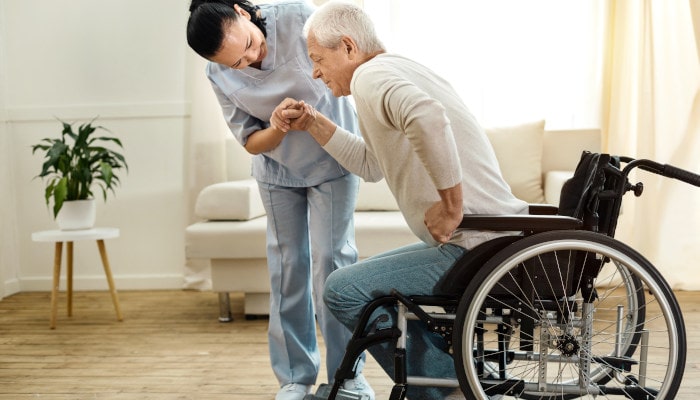How to Manage Pain in the Elderly Population

Pain management in the elderly population presents unique challenges that require a comprehensive approach.
This article aims to provide insights into understanding and assessing pain in older adults, as well as exploring non-pharmacological and pharmacological options for pain relief.
The importance of creating a holistic pain management plan is emphasized, along with strategies to overcome barriers to effective pain management in the senior population.
By addressing these issues, healthcare professionals can enhance the quality of life for elderly individuals experiencing pain.
Key Takeaways
- Physiological changes and comorbidities in the elderly population can complicate pain management.
- Nonverbal pain indicators, such as facial expressions and body movements, are valuable insights for assessing pain in older adults.
- Non-pharmacological approaches like exercise, heat and cold therapy can be effective methods for pain relief in the elderly.
- Mind-body techniques, such as mindfulness meditation and acupuncture, have shown positive effects on pain and well-being in older adults.
Understanding the Unique Challenges of Pain Management in the Elderly
Understanding the unique challenges of pain management in the elderly necessitates an examination of the physiological changes and comorbidities that commonly occur in this population.
Elderly individuals often experience multiple chronic conditions, such as arthritis, osteoporosis, and cardiovascular diseases, which can exacerbate their pain and complicate treatment approaches.
Additionally, age-related physiological changes, including altered drug metabolism and reduced renal function, can impact the effectiveness and safety of pain management interventions.
Pain assessment in older adults can be challenging due to cognitive impairments and communication difficulties. Therefore, healthcare professionals need to employ comprehensive pain management techniques for seniors, including a multidimensional approach that incorporates pharmacological and non-pharmacological interventions.
Pharmacotherapy options should consider the potential risks and benefits, while non-pharmacological strategies, such as physical therapy, cognitive-behavioral therapy, and complementary therapies, can provide alternative avenues for pain relief.
Overall, understanding and addressing the unique challenges faced by elderly individuals can optimize pain management outcomes in this population.
Identifying and Assessing Pain in Older Adults
This discussion focuses on two key points: nonverbal pain indicators and validated pain assessment tools.
Nonverbal pain indicators are important in identifying and assessing pain in older adults as they may have difficulty communicating their pain verbally.
Validated pain assessment tools provide a systematic approach to assessing pain in older adults, ensuring that pain is accurately identified and managed.
Understanding and utilizing these nonverbal pain indicators and validated pain assessment tools can greatly improve the quality of pain management in older adults.
Nonverbal Pain Indicators
Nonverbal pain indicators in the elderly population can provide valuable insights into their pain experience. Understanding and interpreting these nonverbal cues is crucial for effective pain assessment and management in older adults.
Facial expressions: Older adults may exhibit grimacing, frowning, or wincing as nonverbal signs of pain.
Body movements: Restlessness, pacing, or guarding certain body parts can indicate discomfort or pain.
Vocalizations: Nonverbal pain communication can include groaning, moaning, or crying out in response to pain.
Changes in vital signs: Increased heart rate, blood pressure, or respiratory rate may be physiological responses to pain.
It is important for healthcare professionals to be knowledgeable and skilled in recognizing and interpreting these nonverbal pain indicators. By utilizing nonverbal pain assessment techniques, healthcare providers can better understand and address the pain experience of older adults, leading to improved pain management and enhanced quality of life.
Validated Pain Assessment Tools
Validated pain assessment tools play a crucial role in accurately evaluating pain levels and providing effective pain management strategies for older adults. These tools are designed to assess pain in individuals who may have difficulty communicating their pain verbally, such as those with cognitive impairments or language barriers.
Validated pain assessment tools include both self-report and observational measures. Self-report tools, such as the Numeric Rating Scale (NRS) or the Visual Analog Scale (VAS), allow older adults to rate their pain intensity on a numerical or visual scale.
Observational tools, such as the Pain Assessment in Advanced Dementia (PAINAD) scale or the Abbey Pain Scale, rely on the observation of behavioral indicators to assess pain.
These tools help healthcare professionals accurately evaluate pain levels and tailor appropriate pain management techniques for older adults.
Non-Pharmacological Approaches to Pain Relief in the Elderly
This discussion will explore non-pharmacological approaches to pain relief in the elderly, focusing on exercise for pain relief, heat and cold therapy, and mind-body techniques.
These approaches offer potential alternatives to medication for managing pain in older adults.
Exercise for Pain Relief
Exercise has been shown to be an effective method for pain relief in the elderly population. Numerous studies have demonstrated the benefits of exercise in managing pain and improving overall well-being in older adults. Regular physical activity can help reduce pain intensity, enhance joint mobility, and improve muscle strength and flexibility.
Additionally, exercise has been found to increase the release of endorphins, which act as natural painkillers in the body. Moreover, exercise offers a safe and cost-effective alternative to pharmacological interventions, particularly for individuals who may have contraindications or adverse reactions to medications.
Furthermore, exercise can provide additional benefits such as improved cardiovascular health, weight management, and enhanced psychological well-being. Given these advantages, incorporating exercise into the treatment plan for pain relief in the elderly should be considered as part of a comprehensive approach to managing pain.
Heat and Cold Therapy
Heat and cold therapy has been extensively studied and shown to be an effective approach for pain relief in various populations. This therapy involves the application of heat or cold to the affected area, providing temporary relief by altering pain perception and reducing inflammation.
The benefits of heat therapy include increased blood flow, relaxation of muscles, and improved flexibility. Heat therapy can be applied through hot packs, warm baths, or heating pads. It is effective for relieving chronic pain, such as arthritis or muscle stiffness.
Cold therapy, on the other hand, helps to reduce swelling, numb the area, and alleviate pain. Cold therapy can be applied through ice packs or cold compresses. It is beneficial for acute injuries, like sprains or strains.
When considering heat and cold therapy for pain management in the elderly population, it is important to consider the following key points:
- Heat therapy is effective for relieving chronic pain, such as arthritis or muscle stiffness.
- Cold therapy is beneficial for acute injuries, like sprains or strains.
- It is essential to follow proper guidelines and duration of therapy to prevent skin damage or burns.
Overall, heat and cold therapy offer safe and non-invasive options for pain relief in the elderly population.
Mind-Body Techniques
Mind-body techniques, such as meditation and yoga, have been researched extensively and shown to have positive effects on various aspects of health and well-being.
Mindfulness meditation, a form of meditation that involves bringing one’s attention to the present moment, has been found to reduce symptoms of pain and improve overall well-being in individuals of all ages, including the elderly population. This technique helps individuals develop a non-judgmental and accepting attitude towards their pain, which can lead to decreased suffering and improved pain management.
Acupuncture, a traditional Chinese medicine practice that involves the insertion of thin needles into specific points on the body, has also been shown to be effective in managing pain. It is believed that acupuncture stimulates the release of endorphins, which are natural pain-relieving chemicals in the body.
Both mindfulness meditation and acupuncture offer promising non-pharmacological approaches for managing pain in the elderly population. Further research is needed to fully understand the mechanisms and potential benefits of these techniques.
Pharmacological Options for Pain Management in Older Adults
Pharmacological options for pain management in older adults encompass a range of medications that are tailored to the individual’s specific needs and underlying health conditions.
Non-opioid alternatives are often considered as the first line of treatment due to the potential risks associated with opioids in this population. Non-opioid medications such as nonsteroidal anti-inflammatory drugs (NSAIDs), acetaminophen, and adjuvant drugs like antidepressants and anticonvulsants are commonly used.
NSAIDs provide analgesic and anti-inflammatory effects, but caution is warranted due to their potential adverse effects on the gastrointestinal, cardiovascular, and renal systems.
Acetaminophen is generally well-tolerated but may have hepatotoxicity in high doses.
Adjuvant drugs can be useful for managing neuropathic pain, but their use should be individualized based on the patient’s comorbidities and potential drug interactions.
Overall, a multimodal approach, including non-opioid alternatives, should be considered to optimize pain management in older adults while minimizing opioid-related risks.
Creating a Holistic Pain Management Plan for the Elderly
To create a comprehensive pain management plan for older adults, it is important to consider a range of interventions that address the physical, psychological, and social aspects of the individual’s experience.
Taking a holistic approach to pain management involves considering alternative therapies in addition to traditional pharmacological options. Alternative therapies such as acupuncture, massage therapy, and mindfulness-based stress reduction techniques have shown promise in reducing pain and improving quality of life in older adults.
These approaches focus on the whole person, recognizing that pain is not solely a physical sensation but also has psychological and social dimensions. By incorporating alternative therapies into a pain management plan, healthcare professionals can provide older adults with a more comprehensive and individualized approach to pain relief.
This holistic approach may not only reduce reliance on medication but also enhance overall well-being and functional ability in older adults.
Overcoming Barriers to Effective Pain Management in the Senior Population
Barriers to effective pain management in the senior population can hinder the implementation of comprehensive and individualized approaches to address the physical, psychological, and social dimensions of pain. Two significant barriers that contribute to this challenge are barriers in communication and cultural factors.
Communication barriers include difficulties in effectively expressing pain symptoms due to cognitive decline, language barriers, or hearing impairments. These barriers can lead to underreporting of pain or misinterpretation of pain severity, making it challenging for healthcare providers to provide appropriate pain management interventions.
Cultural factors, such as different beliefs and attitudes towards pain and pain management, can also pose barriers. Cultural norms may discourage seniors from seeking pain relief or accepting certain pain management interventions.
Understanding and addressing these barriers are crucial in developing effective pain management strategies for the elderly population.
Frequently Asked Questions
How Does Age Affect the Perception and Experience of Pain in Older Adults?
Age related changes in pain perception and experience in older adults can be influenced by factors such as physiological changes, comorbidities, cognitive decline, and psychosocial factors. Understanding these factors is crucial for effective pain management in the elderly population.
What Are Some Common Non-Pharmacological Approaches to Pain Relief That Can Be Used in the Elderly Population?
Common non-pharmacological approaches, such as alternative therapies, have been utilized for pain relief in the elderly population. These methods aim to alleviate pain without the use of medication, providing additional options for managing pain in this demographic.
Are There Any Specific Pharmacological Options That Should Be Avoided or Used With Caution in Older Adults?
Specific drug interactions and potential adverse effects should be considered when prescribing pharmacological options for pain management in older adults. Alternative therapies may be explored to minimize the risk of drug-related complications.
How Can Caregivers and Healthcare Professionals Effectively Communicate With Elderly Patients About Their Pain?
Effective communication strategies and pain assessment techniques are essential for caregivers and healthcare professionals when interacting with elderly patients. These strategies and techniques enable accurate pain assessment and help in developing appropriate pain management plans.
What Are Some Common Barriers to Effective Pain Management in the Senior Population and How Can They Be Overcome?
Common barriers to effective pain management in the senior population include inadequate assessment, underreporting of pain, and age-related physiological changes. These barriers can be overcome through comprehensive pain assessments, patient education, and individualized treatment plans.








